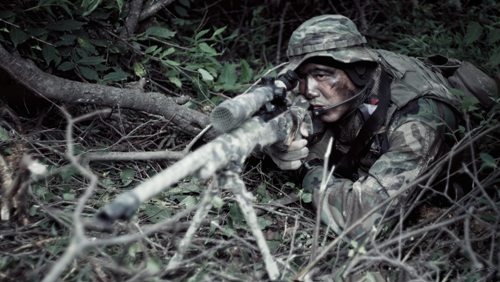Regardless of hunting practice, competition, or honing marksmanship skills, long-range shooting has always been a hard technique. It also aids in boosting your shooting quality.
To better improve your profession and set up for your success, or mainly to better entertain yourselves, learning how to improve your long range shooting is crucial. Our article covers all the essential training techniques you might need to know.

Contents
How To Improve Your Long Range Shooting?
A good long-range shooting depends on several factors, as follows:
Body Position
Before implementing the long-range shooting, make sure you’re in a steady and stable position. It will enhance the steadiness of your shot. Besides, monitor your body to be well-grounded, keep your forearm and both of your elbows on the ground.
In such cases of shooting large calibers over long gaps, let the weaker hand of yours support your rifle’s butt in your shoulder to guarantee your shoulder from the rifle’s recoil.
Be Relaxed
It’s a mistake if you try to force your body position at all times. Finesse and patience would benefit long-range shooting. Accordingly, you’d better ensure you feel comfortable and chilled. Then, the rifle will aim naturally at the initial target. Just complete the precise adjustments to put your crosshairs into your headed goal.
Once your gun needs realigning, you have to move the whole body, get started with your legs instead of twisting the torso. Also, replace or lift the bipod or your gun if needed.

The Flawless View
A full crisp background without shadows is an excellent condition to have a qualified view through your scope. Any tunnel effect or shadows may end up shooting off target due to parallax errors. In such cases of long-range shooting, this theory is indeed exact.
Therefore, what you should do is align two eyes with the ocular bell’s center by completely adjusting your disposal. Then, ensure that your vision is sufficient for the caliber.
After carefully aligning the rear (ocular) and the front lens (objective), move your eyes gradually next to your ocular bell and make two circles. Some also call this the ‘’lining up two circles’’ process, which plays an important part in creating the aperture sights on your target rifles.
Squeezing Your Trigger
Bear in mind that your rifle’s trigger needs squeezing with the pad of your fingernail and index finger, which are parallel to your trigger guard. Enabling the gun to go straight back into you after you have fired each shot. Moreover, don’t forget to pay attention to your grip.
Many sharpshooters apply an opposing force through the thumb to offset the pressure exerted on the trigger. As a result, they maintain neutral contact during the process.
Focus On Your Crosshairs
Make sure to remember the place where the crosshairs are while you break your shot. Then, refocus the moment your bullet lands on the ground or hits your target. More often than not, a calm concentration is a must for long-range shooting, yet it’s acceptable to skip the recoil caused by the magnum calibers.
Furthermore, focusing entirely on your target and retaining a post-shot sight is necessary to resist flinching.
Holding Your Rifle
Some will make the mistake of holding their rifle tightly to control recoil. It would help if you only held the gun to a moderate degree of firmness. You need to maintain a comfortable yet firm grip from the specific position to help your entire body dissipate the recoil conveniently throughout the whole shot.
Get Started From The Ground Up
Trying to practice shooting at close range is a good start for succeeding in getting long-range shooting. Once you get accustomed to short-range shooting habits, you’ll be more confident in using equipment and utilizing skills.
Why? Once you are adept at the closer range, you could grasp the knowledge for hitting the target with ease. Consequently, you will know how to adjust your gun to aim precisely.
Know-How Gravity And Wind Effect On Your Bullets
Long-range shots often have to bear external factors. Investing in an anemometer, a niche ammo solution, or the laser finder would be the best for your rifle.
Moreover, taking the time to combine ammunition and upgrade the loading process for the gun is well worth doing. Besides additional support from equipment, being thoroughly aware of environmental conditions and wind direction will also give you better results per shot.
Environmental Factors

In addition to a know-how understanding of the wind direction and speed at a firing point, you must have insight into the terrain, trees, lowering, and upgrading channels. All these criteria will significantly affect the flight path of your bullet.
When taking long-range shots, make sure you consider all the conditions in favor of the shot, especially sensing the wind’s direction along the bullet’s trajectory. You could determine this direction by the movements of surrounding trees.
It’s not easy to do for the first aim, yet you can become a marksman with constant and hard practice. So let’s make an exclusive!
Set Yourselves Up For Success
During shooting games, you often have to face the harsh reality of shooting several yards away, or sometimes under bad conditions.
Therefore, you’d better focus on developing long-range shooting skills with high spirit. Set up your routine unconsciously step-by-step by instantly honing the marksmanship ability. It will aid you in concentrating on your quarry and fieldcraft better. Once your techniques are good enough, you can make a good shot with seeming ease.
The Key Takeaway
You know all the main factors influencing your long-range shooting’s result. After grasping the fundamental techniques to improve your long range shooting, take them into practice at once! Especially newbies, reading any manual first would be a wise preparation.

I am Jerry Gonzalez, and my heart beats for the great outdoors, especially in the breathtaking landscapes of Helena, Montana. Engaging with fellow enthusiasts online and at local hunting clubs has been a rewarding experience, and I find great joy in sharing knowledge and experiences with like-minded individuals. My goal is to empower my fellow hunters with well-informed choices, regardless of their experience level.
